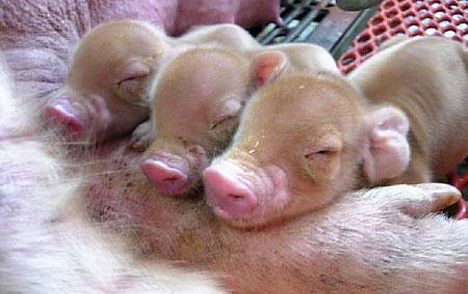
In a development that brings us one step closer toward the mass-cloning of animals for use in regenerative medicine, researchers from Meiji University have succeeded in creating the world's first fourth-generation pig clones.
Since creating a pair of pig clones in April 2004, professor Hiroshi Nagashima, the research team leader, has been recloning the clones using cells from their salivary glands. The fourth-generation piglets -- three of them born on July 23 -- are clones of clones of clones of clones, so they share the exact DNA as the original pig.
Scientists have been seeking to advance pig cloning technology because pig organs are physiologically similar to human organs, meaning they could be the key to alleviating the worldwide shortage of organs for transplant.
Past examples of animals that have been cloned through multiple generations include mice, which have been recloned up to the sixth generation, and cows, which have been recloned to the second generation. While recloning technology may promise to boost the productivity of cloning operations, there are some drawbacks. For instance, in somatic cell nuclear transfer -- a reproductive cloning technique where the nucleus from a donor adult cell (somatic cell) is transferred to a nucleus-free egg cell, which is then transferred into the uterus of a surrogate mother -- DNA damage accumulates with each generation that is cloned. After a number of generations, the cumulative damage to the DNA could result in an animal that is significantly different from the original.
So far, however, the fourth-generation pig clones show no signs of abnormalities, and the researchers are planning to reclone them again.
In addition to creating the world's first fourth-generation pig clones, Nagashima's team also reported success in using a combination of gene transfer technology and cloning technology to create transgenic diabetic pigs -- pigs with human genes that exhibit symptoms of diabetes mellitus. The researchers worked with BIOS Inc., a venture company based in Kanagawa prefecture, to engineer the pigs.
While we have seen transgenic diabetic mice in the past, these transgenic diabetic pigs are reportedly the first of their kind. With the anatomical similarities between man and swine, transgenic diabetic pigs could lead to a cure for diabetes by helping scientists develop transplant technology involving the use of pig pancreatic tissue, a potential source of insulin. In addition, the pigs can also serve as models for observing the complications associated with diabetes, such as arteriosclerosis, and they could help researchers develop new medicines.
Professor Nagashima suggests that in addition to serving as model animals for human diseases, individuals will be able to use their own cells in these bioengineered pigs to test the effectiveness and safety of regenerative medicine therapies.

M. Charlotte
I understand how re-cloning the clones (and the clones of clones, clones of clones of clones, etc.) can speed up the whole process and yield more clones in a shorter time, but are there any other reasons for doing this (other than for the sake of experimentation)? Why would we ever need so many clones of a single animal? Surely no hog farmers are considering the possibility of mass cloning their prize bacon pigs!
[]Dee Lightly
"...but are there any other reasons for doing this (other than for the sake of experimentation)?"
That reason alone is good enough for me. If there's potential for real human benefit in the long run, I'm all for it.
It's also interesting to hear that the clones of clones aren't genetic abnormalities (I've seen that lame Michael Keaton cloning movie too many time). I'm wondering if this has more to do with advancements in cloning technology or the genetic makeup of the pigs.
[]piglover
i can see how this could help humans, but how are you going to get the organs from the animals? just kill them solely for the reason of one organ? Are the medical doctors just going to slice them open for an organ? A death is a death wether it be human or animal. This is almost as cruel as living conditions in commercial pig farms!
[]poo face
i do think that the above pigs look like cows. so i think you're WRONG they're not pigs they're COWSS
moooo cows...not oink oink pigs!
I THINK YOU DID SOMETHING REALLY WRONG
thankyou :D
[]anonymous criticism
Yeah, they're cute and all, but what's the big deal??? Those litle piggies don't really do as much as they would for our nutritional enjoyment!!! EAT THEM PEOPLE!!! Those pigs don;t look like cows, they look like oink-oink pigs!!! you can tell by the short, stubby, PINK, FUZZY snouts!!! cows don;t have snouts, they have noses. you can also tell by their pig skulls, which are elongated and thin! cow skulls are broad at the top, and thin at the base. but, pig does taste better than cow, which always tastes like chicken!!!!
[]anonymous criticism
they taste like children
[]reply to piglover
if a death is a death, what do you believe about abortion? is it a death or a choice?? pig life should not even close to the value of human life... if you were dying of organ failure, would you rather just die or have the chance to live another 10 years with a new organ... ????
[]wtf
YURK!!!!!!!!
[]DEATH IS NATURAL
Face it PLZS!!!!
Mazie Fluker
Hi I loved your article. I think that it's important when talking about diabetes to at least bring up natural treatments that have been shown to be efficient in controlling high blood glucose. Many natural herbs can be including in a diabetics routine that can help keep a healthy sugar level.
[]